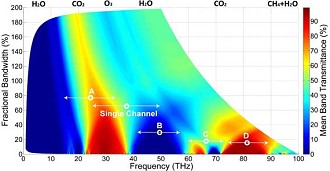Predicting Atmospheric Attenuation Under Pristine Conditions Between 0.1 and 100 THz |


Press Release Archives: 2024 | 2023 | 2022 | 2021 |2020 2019 | 2018 | 2017 | 2016 | 2015 2014 | 2013 | 2012 | 2011 | 2010 2009 | 2008 | 2007 | 2006 | 2005 Content is copyright of company represented. Page format, custom text and images are RF Cafe copyright - do not distribute. Department of Electrical and Electronic Engineering, Centre for Terahertz Science and Engineering, Imperial College London, London, U.K. The growing and vibrant Terahertz R&D community is creating major breakthroughs in science & engineering and now offers the realistic prospect of commercial exploitation for niche applications.
For decades, the atmospheric science community has been characterizing atmospheric attenuation over be-spoke path links. However, outside of this community, THz technologists and practitioners may not have exploited the wealth of knowledge and modelling software that exists. We recently published an open access paper entitled "Predicting atmospheric attenuation under pristine conditions between 0.1 and 100 THz", in the multidisciplinary journal IEEE Access. This can be freely downloaded at the publisher's website: http://ieeexplore.ieee.org/document/7736955 This entry-level article was written from an engineer's perspective and represents both a mini-Review and research-led Technical Note. Of practical significance, with different scenarios under pristine conditions, we show how a freely available and easy to use online software package can qualitatively predict atmospheric attenuation and how the results from this convenient tool compare with quantitative predictions from more sophisticated software packages. About the Authors Jingye Sun: Department of Electrical and Electronic Engineering, Centre for Terahertz Science and Engineering, Imperial College London, London, U.K. Fangjing Hu: Department of Electrical and Electronic Engineering, Centre for Terahertz Science and Engineering, Imperial College London, London, U.K. Stepan Lucyszyn: Department of Electrical and Electronic Engineering, Centre for Terahertz Science and Engineering, Imperial College London, London, U.K. Contact Department of Electrical and Electronic Engineering Centre for Terahertz Science and Engineering Imperial College London, London, U.K. E-Mail: lucyszyn@imperial.ac.uk Website: www.imperial.ac.uk/terahertz
Posted February 27, 2017 |
 Atmospheric attenuation
Atmospheric attenuation